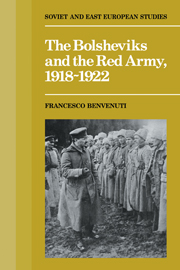Book contents
7 - Peace or war
Published online by Cambridge University Press: 03 October 2009
Summary
Extension of military methods to the economy
Towards the end of 1919, the Soviet authorities began to focus their efforts on the development of means of mobilizing urban and rural manpower, based on the obligation to work (‘universal compulsory labour’), and on the introduction of military-style discipline in the major branches of industry and the economy. The first moves in this direction were made right at the beginning of ‘War Communism’, and the War Ministry was one of their main promoters. In July 1918, VVS had stated its support for the decision ‘to place under its [own] command, and to militarize, the staff of the railways, and in general that of means of communication, such as roads, troop transport vehicles, military supplies, and evacuations’. In November 1918, Trotskii had asked government, party, and Transport Commissariat officials to have the railway system ‘militarized’, since ‘the introduction of military discipline on the railways is a matter of vital necessity’. Pursuing an already familiar line of argument, Vatsetis, in February 1919, explicitly urged Lenin that the various different Commissariats should cease ‘to lead separate lives’, and that it be acknowledged in political and organizational terms that ‘the Commissariat for War is the motive force of the current period’.
The militarization of labour was the government's overriding commitment during the months leading up to the outbreak of hostilities with Poland. Lenin himself, at both the 8th Party Conference and at the 7th Congress of Soviets, had placed this objective squarely on the agenda.
- Type
- Chapter
- Information
- The Bolsheviks and the Red Army 1918–1921 , pp. 162 - 194Publisher: Cambridge University PressPrint publication year: 1988



